【Python】关于DataFrame数据类型二三事
关于DataFrame数据类型二三事
·
数据类型:DataFrame
1 外貌
1.1 初始面貌
只有列索引
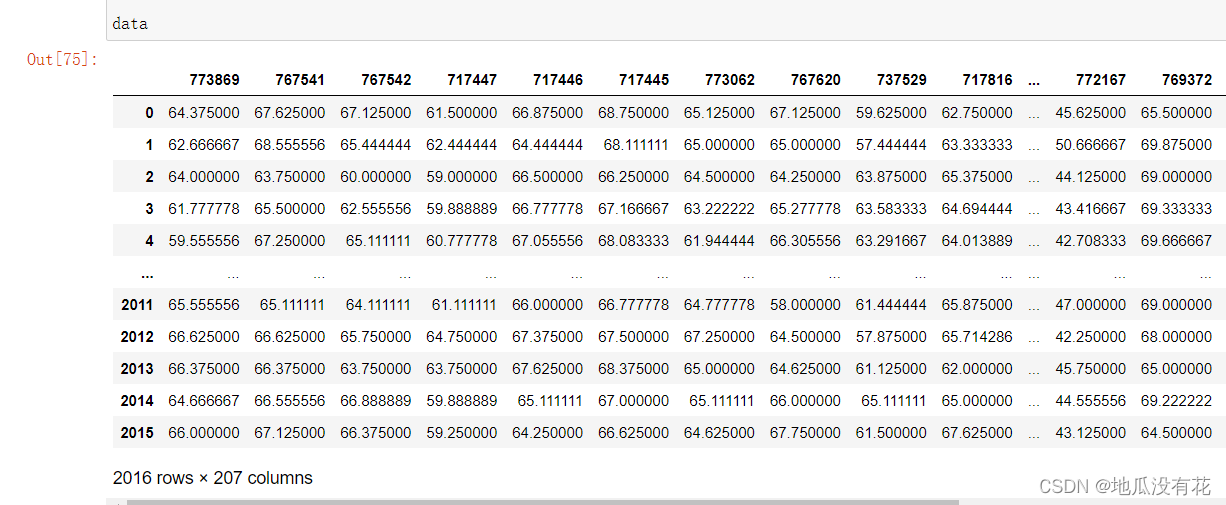
1.2 整形后
加上了行索引

上述是一个关于交通速度记录的数据,列index表示传感器的编号,行index表示时间,每隔十五分钟。
1.3 整形项目
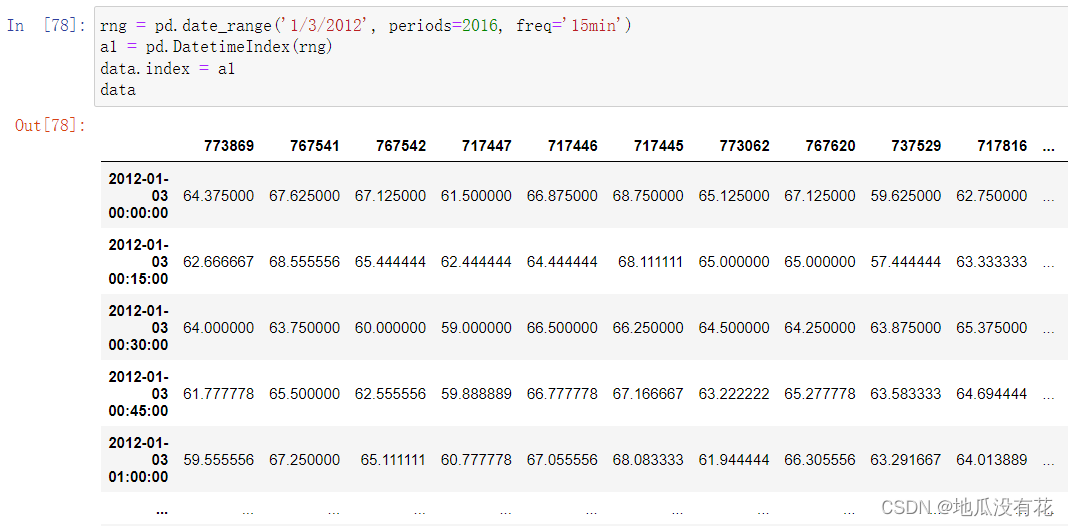
即:
rng = pd.date_range('1/3/2012', periods=2016, freq='15min')
a1 = pd.DatetimeIndex(rng)
data.index = a1
1.4 改头换面
将其他数据类型转换为DataFrame数据类型
(1)pd.Dataframe() 方法
pd.Dataframe(data, columns=[‘列名’])
(2)data.to_fame() 方法
data.to_frame(name=‘列名’)
2 姓名
对于上述数据的类型是:DataFrame

3 技能
3.1 查看index
查看行索引:data.index
查看列索引:data.columns 或者 data.iloc[0].index
(1)查看列索引
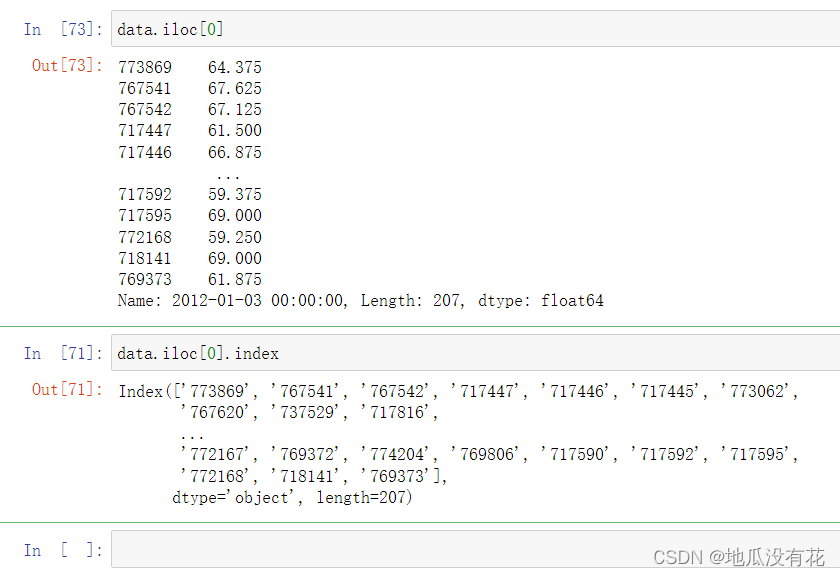
如图所示,data.iloc[0] 表示查看第一行数据,此时是带index的;若是想查看列index,则是data.iloc[0].index。
data.columns 也可以查看列索引。

(2)查看行索引
查看行index的则是data.index。
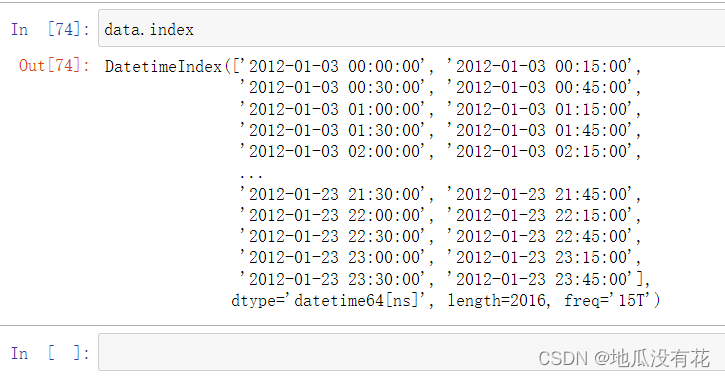
3.2 查看values
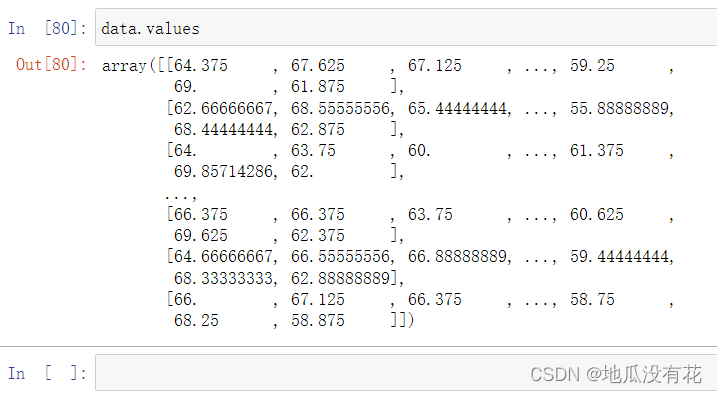
3.3 取指定行/列
使用下标:data.iloc[0:2,:]
使用索引:data.loc[:,'773869':'767542']
(1)data.iloc[0:2,:] 表示取前两行(前闭后开区间);.iloc 是使用数据下标来取值。

(2)data.loc[:,'773869':'767542'] 表示取前三列(前闭后闭区间);.loc 是使用标签即index来取值。
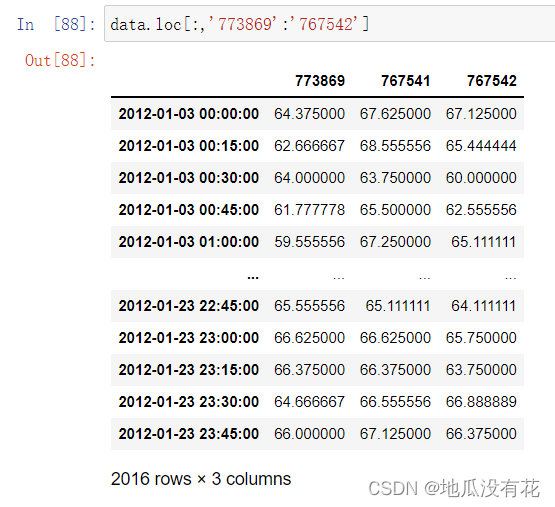
注:DataFrame类型的数据不能直接使用下标取值
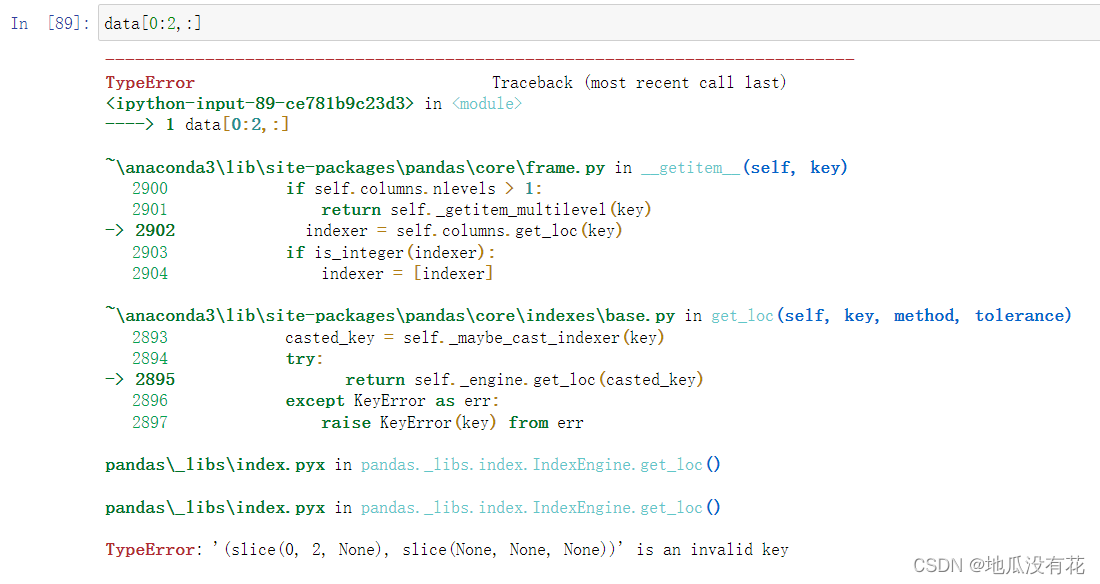
3.4 转换为list类型
使用data.values.tolist() 语句进行转换。

上图可知:不能直接使用.tolist()。
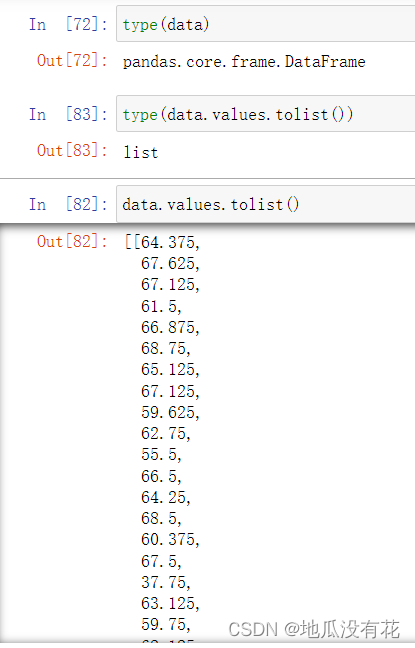
4 DataFrame基本函数
4.1 构造数据框
DataFrame([data, index, columns, dtype, copy]) #构造数据框
4.2 属性和数据
DataFrame.axes #index: 行标签;columns: 列标签
DataFrame.as_matrix([columns]) #转换为矩阵
DataFrame.dtypes #返回数据的类型
DataFrame.ftypes #返回每一列的 数据类型float64:dense
DataFrame.get_dtype_counts() #返回数据框数据类型的
4.3 个数
DataFrame.get_ftype_counts() #返回数据框数据类型float64:dense的个数
DataFrame.select_dtypes([include, include]) #根据数据类型选取子数据框
DataFrame.values #Numpy的展示方式
DataFrame.axes #返回横纵坐标的标签名
DataFrame.ndim #返回数据框的纬度
DataFrame.size #返回数据框元素的个数
DataFrame.shape #返回数据框的形状
DataFrame.memory_usage() #每一列的存储
4.4 索引和迭代
DataFrame.head([n]) #返回前n行数据
DataFrame.at #快速标签常量访问器
DataFrame.iat #快速整型常量访问器
DataFrame.loc #标签定位,使用名称
DataFrame.iloc #整型定位,使用数字
DataFrame.insert(loc, column, value) #在特殊地点loc[数字]插入column[列名]某列数据
DataFrame.iter() #Iterate over infor axis
DataFrame.iteritems() #返回列名和序列的迭代器
DataFrame.iterrows() #返回索引和序列的迭代器
DataFrame.itertuples([index, name]) #Iterate over DataFrame rows as namedtuples, with index value as first element of the tuple.
DataFrame.lookup(row_labels, col_labels) #Label-based “fancy indexing” function for DataFrame.
DataFrame.pop(item) #返回删除的项目
DataFrame.tail([n]) #返回最后n行
DataFrame.xs(key[, axis, level, drop_level]) #Returns a cross-section (row(s) or column(s)) from the Series/DataFrame.
DataFrame.isin(values) #是否包含数据框中的元素
DataFrame.where(cond[, other, inplace, …]) #条件筛选
DataFrame.mask(cond[, other, inplace, …]) #Return an object of same shape as self and whose corresponding entries are from self where cond is False and otherwise are from other.
DataFrame.query(expr[, inplace]) #Query the columns of a frame with a boolean expression.
4.5 全部
DataFrame([data, index, columns, dtype, copy]) #构造数据框
属性和数据
DataFrame.axes #index: 行标签;columns: 列标签
DataFrame.as_matrix([columns]) #转换为矩阵
DataFrame.dtypes #返回数据的类型
DataFrame.ftypes #返回每一列的 数据类型float64:dense
DataFrame.get_dtype_counts() #返回数据框数据类型的个数
DataFrame.get_ftype_counts() #返回数据框数据类型float64:dense的个数
DataFrame.select_dtypes([include, include]) #根据数据类型选取子数据框
DataFrame.values #Numpy的展示方式
DataFrame.axes #返回横纵坐标的标签名
DataFrame.ndim #返回数据框的纬度
DataFrame.size #返回数据框元素的个数
DataFrame.shape #返回数据框的形状
DataFrame.memory_usage() #每一列的存储
类型转换
DataFrame.astype(dtype[, copy, errors]) #转换数据类型
DataFrame.copy([deep]) #deep深度复制数据
DataFrame.isnull() #以布尔的方式返回空值
DataFrame.notnull() #以布尔的方式返回非空值
索引和迭代
DataFrame.head([n]) #返回前n行数据
DataFrame.at #快速标签常量访问器
DataFrame.iat #快速整型常量访问器
DataFrame.loc #标签定位,使用名称
DataFrame.iloc #整型定位,使用数字
DataFrame.insert(loc, column, value) #在特殊地点loc[数字]插入column[列名]某列数据
DataFrame.iter() #Iterate over infor axis
DataFrame.iteritems() #返回列名和序列的迭代器
DataFrame.iterrows() #返回索引和序列的迭代器
DataFrame.itertuples([index, name]) #Iterate over DataFrame rows as namedtuples, with index value as first element of the tuple.
DataFrame.lookup(row_labels, col_labels) #Label-based “fancy indexing” function for DataFrame.
DataFrame.pop(item) #返回删除的项目
DataFrame.tail([n]) #返回最后n行
DataFrame.xs(key[, axis, level, drop_level]) #Returns a cross-section (row(s) or column(s)) from the Series/DataFrame.
DataFrame.isin(values) #是否包含数据框中的元素
DataFrame.where(cond[, other, inplace, …]) #条件筛选
DataFrame.mask(cond[, other, inplace, …]) #Return an object of same shape as self and whose corresponding entries are from self where cond is False and otherwise are from other.
DataFrame.query(expr[, inplace]) #Query the columns of a frame with a boolean expression.
二元运算
DataFrame.add(other[,axis,fill_value]) #加法,元素指向
DataFrame.sub(other[,axis,fill_value]) #减法,元素指向
DataFrame.mul(other[, axis,fill_value]) #乘法,元素指向
DataFrame.div(other[, axis,fill_value]) #小数除法,元素指向
DataFrame.truediv(other[, axis, level, …]) #真除法,元素指向
DataFrame.floordiv(other[, axis, level, …]) #向下取整除法,元素指向
DataFrame.mod(other[, axis,fill_value]) #模运算,元素指向
DataFrame.pow(other[, axis,fill_value]) #幂运算,元素指向
DataFrame.radd(other[, axis,fill_value]) #右侧加法,元素指向
DataFrame.rsub(other[, axis,fill_value]) #右侧减法,元素指向
DataFrame.rmul(other[, axis,fill_value]) #右侧乘法,元素指向
DataFrame.rdiv(other[, axis,fill_value]) #右侧小数除法,元素指向
DataFrame.rtruediv(other[, axis, …]) #右侧真除法,元素指向
DataFrame.rfloordiv(other[, axis, …]) #右侧向下取整除法,元素指向
DataFrame.rmod(other[, axis,fill_value]) #右侧模运算,元素指向
DataFrame.rpow(other[, axis,fill_value]) #右侧幂运算,元素指向
DataFrame.lt(other[, axis, level]) #类似Array.lt
DataFrame.gt(other[, axis, level]) #类似Array.gt
DataFrame.le(other[, axis, level]) #类似Array.le
DataFrame.ge(other[, axis, level]) #类似Array.ge
DataFrame.ne(other[, axis, level]) #类似Array.ne
DataFrame.eq(other[, axis, level]) #类似Array.eq
DataFrame.combine(other,func[,fill_value, …]) #Add two DataFrame objects and do not propagate NaN values, so if for a
DataFrame.combine_first(other) #Combine two DataFrame objects and default to non-null values in frame calling the method.
函数应用&分组&窗口
DataFrame.apply(func[, axis, broadcast, …]) #应用函数
DataFrame.applymap(func) #Apply a function to a DataFrame that is intended to operate elementwise, i.e.
DataFrame.aggregate(func[, axis]) #Aggregate using callable, string, dict, or list of string/callables
DataFrame.transform(func, *args, **kwargs) #Call function producing a like-indexed NDFrame
DataFrame.groupby([by, axis, level, …]) #分组
DataFrame.rolling(window[, min_periods, …]) #滚动窗口
DataFrame.expanding([min_periods, freq, …]) #拓展窗口
DataFrame.ewm([com, span, halflife, …]) #指数权重窗口
描述统计学
DataFrame.abs() #返回绝对值
DataFrame.all([axis, bool_only, skipna]) #Return whether all elements are True over requested axis
DataFrame.any([axis, bool_only, skipna]) #Return whether any element is True over requested axis
DataFrame.clip([lower, upper, axis]) #Trim values at input threshold(s).
DataFrame.clip_lower(threshold[, axis]) #Return copy of the input with values below given value(s) truncated.
DataFrame.clip_upper(threshold[, axis]) #Return copy of input with values above given value(s) truncated.
DataFrame.corr([method, min_periods]) #返回本数据框成对列的相关性系数
DataFrame.corrwith(other[, axis, drop]) #返回不同数据框的相关性
DataFrame.count([axis, level, numeric_only]) #返回非空元素的个数
DataFrame.cov([min_periods]) #计算协方差
DataFrame.cummax([axis, skipna]) #Return cumulative max over requested axis.
DataFrame.cummin([axis, skipna]) #Return cumulative minimum over requested axis.
DataFrame.cumprod([axis, skipna]) #返回累积
DataFrame.cumsum([axis, skipna]) #返回累和
DataFrame.describe([percentiles,include, …]) #整体描述数据框
DataFrame.diff([periods, axis]) #1st discrete difference of object
DataFrame.eval(expr[, inplace]) #Evaluate an expression in the context of the calling DataFrame instance.
DataFrame.kurt([axis, skipna, level, …]) #返回无偏峰度Fisher’s (kurtosis of normal == 0.0).
DataFrame.mad([axis, skipna, level]) #返回偏差
DataFrame.max([axis, skipna, level, …]) #返回最大值
DataFrame.mean([axis, skipna, level, …]) #返回均值
DataFrame.median([axis, skipna, level, …]) #返回中位数
DataFrame.min([axis, skipna, level, …]) #返回最小值
DataFrame.mode([axis, numeric_only]) #返回众数
DataFrame.pct_change([periods, fill_method]) #返回百分比变化
DataFrame.prod([axis, skipna, level, …]) #返回连乘积
DataFrame.quantile([q, axis, numeric_only]) #返回分位数
DataFrame.rank([axis, method, numeric_only]) #返回数字的排序
DataFrame.round([decimals]) #Round a DataFrame to a variable number of decimal places.
DataFrame.sem([axis, skipna, level, ddof]) #返回无偏标准误
DataFrame.skew([axis, skipna, level, …]) #返回无偏偏度
DataFrame.sum([axis, skipna, level, …]) #求和
DataFrame.std([axis, skipna, level, ddof]) #返回标准误差
DataFrame.var([axis, skipna, level, ddof]) #返回无偏误差
从新索引&选取&标签操作
DataFrame.add_prefix(prefix) #添加前缀
DataFrame.add_suffix(suffix) #添加后缀
DataFrame.align(other[, join, axis, level]) #Align two object on their axes with the
DataFrame.drop(labels[, axis, level, …]) #返回删除的列
DataFrame.drop_duplicates([subset, keep, …]) #Return DataFrame with duplicate rows removed, optionally only
DataFrame.duplicated([subset, keep]) #Return boolean Series denoting duplicate rows, optionally only
DataFrame.equals(other) #两个数据框是否相同
DataFrame.filter([items, like, regex, axis]) #过滤特定的子数据框
DataFrame.first(offset) #Convenience method for subsetting initial periods of time series data based on a date offset.
DataFrame.head([n]) #返回前n行
DataFrame.idxmax([axis, skipna]) #Return index of first occurrence of maximum over requested axis.
DataFrame.idxmin([axis, skipna]) #Return index of first occurrence of minimum over requested axis.
DataFrame.last(offset) #Convenience method for subsetting final periods of time series data based on a date offset.
DataFrame.reindex([index, columns]) #Conform DataFrame to new index with optional filling logic, placing NA/NaN in locations having no value in the previous index.
DataFrame.reindex_axis(labels[, axis, …]) #Conform input object to new index with optional filling logic, placing NA/NaN in locations having no value in the previous index.
DataFrame.reindex_like(other[, method, …]) #Return an object with matching indices to myself.
DataFrame.rename([index, columns]) #Alter axes input function or functions.
DataFrame.rename_axis(mapper[, axis, copy]) #Alter index and / or columns using input function or functions.
DataFrame.reset_index([level, drop, …]) #For DataFrame with multi-level index, return new DataFrame with labeling information in the columns under the index names, defaulting to ‘level_0’, ‘level_1’, etc.
DataFrame.sample([n, frac, replace, …]) #返回随机抽样
DataFrame.select(crit[, axis]) #Return data corresponding to axis labels matching criteria
DataFrame.set_index(keys[, drop, append ]) #Set the DataFrame index (row labels) using one or more existing columns.
DataFrame.tail([n]) #返回最后几行
DataFrame.take(indices[, axis, convert]) #Analogous to ndarray.take
DataFrame.truncate([before, after, axis ]) #Truncates a sorted NDFrame before and/or after some particular index value.
处理缺失值
DataFrame.dropna([axis, how, thresh, …]) #Return object with labels on given axis omitted where alternately any
DataFrame.fillna([value, method, axis, …]) #填充空值
DataFrame.replace([to_replace, value, …]) #Replace values given in ‘to_replace’ with ‘value’.
从新定型&排序&转变形态
DataFrame.pivot([index, columns, values]) #Reshape data (produce a “pivot” table) based on column values.
DataFrame.reorder_levels(order[, axis]) #Rearrange index levels using input order.
DataFrame.sort_values(by[, axis, ascending]) #Sort by the values along either axis
DataFrame.sort_index([axis, level, …]) #Sort object by labels (along an axis)
DataFrame.nlargest(n, columns[, keep]) #Get the rows of a DataFrame sorted by the n largest values of columns.
DataFrame.nsmallest(n, columns[, keep]) #Get the rows of a DataFrame sorted by the n smallest values of columns.
DataFrame.swaplevel([i, j, axis]) #Swap levels i and j in a MultiIndex on a particular axis
DataFrame.stack([level, dropna]) #Pivot a level of the (possibly hierarchical) column labels, returning a DataFrame (or Series in the case of an object with a single level of column labels) having a hierarchical index with a new inner-most level of row labels.
DataFrame.unstack([level, fill_value]) #Pivot a level of the (necessarily hierarchical) index labels, returning a DataFrame having a new level of column labels whose inner-most level consists of the pivoted index labels.
DataFrame.melt([id_vars, value_vars, …]) #“Unpivots” a DataFrame from wide format to long format, optionally
DataFrame.T #Transpose index and columns
DataFrame.to_panel() #Transform long (stacked) format (DataFrame) into wide (3D, Panel) format.
DataFrame.to_xarray() #Return an xarray object from the pandas object.
DataFrame.transpose(*args, **kwargs) #Transpose index and columns
Combining& joining&merging
DataFrame.append(other[, ignore_index, …]) #追加数据
DataFrame.assign(**kwargs) #Assign new columns to a DataFrame, returning a new object (a copy) with all the original columns in addition to the new ones.
DataFrame.join(other[, on, how, lsuffix, …]) #Join columns with other DataFrame either on index or on a key column.
DataFrame.merge(right[, how, on, left_on, …]) #Merge DataFrame objects by performing a database-style join operation by columns or indexes.
DataFrame.update(other[, join, overwrite, …]) #Modify DataFrame in place using non-NA values from passed DataFrame.
时间序列
DataFrame.asfreq(freq[, method, how, …]) #将时间序列转换为特定的频次
DataFrame.asof(where[, subset]) #The last row without any NaN is taken (or the last row without
DataFrame.shift([periods, freq, axis]) #Shift index by desired number of periods with an optional time freq
DataFrame.first_valid_index() #Return label for first non-NA/null value
DataFrame.last_valid_index() #Return label for last non-NA/null value
DataFrame.resample(rule[, how, axis, …]) #Convenience method for frequency conversion and resampling of time series.
DataFrame.to_period([freq, axis, copy]) #Convert DataFrame from DatetimeIndex to PeriodIndex with desired
DataFrame.to_timestamp([freq, how, axis]) #Cast to DatetimeIndex of timestamps, at beginning of period
DataFrame.tz_convert(tz[, axis, level, copy]) #Convert tz-aware axis to target time zone.
DataFrame.tz_localize(tz[, axis, level, …]) #Localize tz-naive TimeSeries to target time zone.
作图
DataFrame.plot([x, y, kind, ax, ….]) #DataFrame plotting accessor and method
DataFrame.plot.area([x, y]) #面积图Area plot
DataFrame.plot.bar([x, y]) #垂直条形图Vertical bar plot
DataFrame.plot.barh([x, y]) #水平条形图Horizontal bar plot
DataFrame.plot.box([by]) #箱图Boxplot
DataFrame.plot.density(**kwds) #核密度Kernel Density Estimate plot
DataFrame.plot.hexbin(x, y[, C, …]) #Hexbin plot
DataFrame.plot.hist([by, bins]) #直方图Histogram
DataFrame.plot.kde(**kwds) #核密度Kernel Density Estimate plot
DataFrame.plot.line([x, y]) #线图Line plot
DataFrame.plot.pie([y]) #饼图Pie chart
DataFrame.plot.scatter(x, y[, s, c]) #散点图Scatter plot
DataFrame.boxplot([column, by, ax, …]) #Make a box plot from DataFrame column optionally grouped by some columns or
DataFrame.hist(data[, column, by, grid, …]) #Draw histogram of the DataFrame’s series using matplotlib / pylab.
转换为其他格式
DataFrame.from_csv(path[, header, sep, …]) #Read CSV file (DEPRECATED, please use pandas.read_csv() instead).
DataFrame.from_dict(data[, orient, dtype]) #Construct DataFrame from dict of array-like or dicts
DataFrame.from_items(items[,columns,orient]) #Convert (key, value) pairs to DataFrame.
DataFrame.from_records(data[, index, …]) #Convert structured or record ndarray to DataFrame
DataFrame.info([verbose, buf, max_cols, …]) #Concise summary of a DataFrame.
DataFrame.to_pickle(path[, compression, …]) #Pickle (serialize) object to input file path.
DataFrame.to_csv([path_or_buf, sep, na_rep]) #Write DataFrame to a comma-separated values (csv) file
DataFrame.to_hdf(path_or_buf, key, **kwargs) #Write the contained data to an HDF5 file using HDFStore.
DataFrame.to_sql(name, con[, flavor, …]) #Write records stored in a DataFrame to a SQL database.
DataFrame.to_dict([orient, into]) #Convert DataFrame to dictionary.
DataFrame.to_excel(excel_writer[, …]) #Write DataFrame to an excel sheet
DataFrame.to_json([path_or_buf, orient, …]) #Convert the object to a JSON string.
DataFrame.to_html([buf, columns, col_space]) #Render a DataFrame as an HTML table.
DataFrame.to_feather(fname) #write out the binary feather-format for DataFrames
DataFrame.to_latex([buf, columns, …]) #Render an object to a tabular environment table.
DataFrame.to_stata(fname[, convert_dates, …]) #A class for writing Stata binary dta files from array-like objects
DataFrame.to_msgpack([path_or_buf, encoding]) #msgpack (serialize) object to input file path
DataFrame.to_sparse([fill_value, kind]) #Convert to SparseDataFrame
DataFrame.to_dense() #Return dense representation of NDFrame (as opposed to sparse)
DataFrame.to_string([buf, columns, …]) #Render a DataFrame to a console-friendly tabular output.
DataFrame.to_clipboard([excel, sep]) #Attempt to write text representation of object to the system clipboard
5 更多了解:
更多推荐
 已为社区贡献5条内容
已为社区贡献5条内容










所有评论(0)